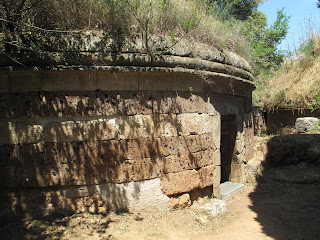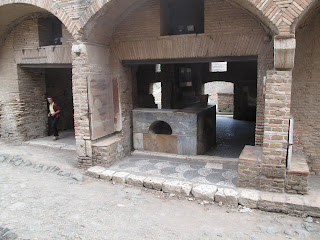The next
day we rented a car at the main train station and headed north to Viterbo, our
base for exploring the region just north of Rome. Getting out of Rome was a nightmare. We had neglected to buy a detailed city map
and Hertz had nothing to tell us except “Take the Via Salaria!” The city itself has no signage. After several circlings and backtrackings and
some shouting at each other, we eventually found ourselves on the road to
Viterbo.
Viterbo is a smallish
city, sprawling over hilly terrain.
It’s
known to Italian tourists
but not much to foreigners, despite a large medieval
center with narrow streets and buildings of dark stone (probably rather gloomy
in the winter) and some very good restaurants.
On the edges of the old town, familiar 19th century architecture lines
the squares.
After a late lunch of tasty panini
(sandwiches), we drove 15 km to the hilltop town of Bomarzo to see the Park of
the Monsters, aka the Sacred Grove. In a
remote valley below the town, Pier Francisco Orsini, a local noble, created
this garden in the mid 16th century. On hillsides and terraces, amidst trees,
bushes, and grass, colossal statues were carved out of bedrock.
Some are monsters.
Some refer to classical mythology.
Some are logic-defying, like the tilted house.
And some structures, like the imitation temple at the top, evoke classical
architecture, which was of great interest in the Renaissance.
The garden is privately owned – imagine,
owing a garden like this! – but well organized for visitors.
A few days later
we visited another Renaissance garden, but of a very different sort. At the Villa Lante, at Bagnaia just outside Viterbo,
the gardens with wonderful water features are symmetrically laid out on a
hillside, in a series of terraces.
Each
level has its own peculiarities: grottos with waterfalls, water spewing out of
the mouths of grotesques, large sculpture groups, fountains of various sorts,
and different planting designs.
Calculating
the water flow was surely a big challenge for the hydraulics engineer, Tomasso
Ghinucci from Siena, but he rose to the task perfectly.
Our main purpose
in visiting this region, however, was archaeological. One goal was to see Cosa, the other to have a
look at some Etruscan tombs.
Cosa is a major example of a city during the
Roman Republic, a period poorly known in Rome itself because of later imperial,
Renaissance, and modern construction.
The site is located on hills above the
Mediterranean coast, a lovely setting.
Cosa: city walls and gate
At
the very top, high up with a fabulous view, is the arx (Latin: the citadel), a small walled area enclosing the city’s
principal temples. The forum lies at a lower level.
The current excavations (under the direction
of Andrea De Giorgi, of Florida State University) are exploring a bath complex,
in and around olive trees still very much part of the privately owned
landscape.
For much of the
first millennium BC this entire region – Viterbo, Bomarzo, Cosa – was Etruscan
territory. The Etruscans were an Italic
people dominating the center of the peninsula, from Rome north to Florence and
even beyond, until the expanding Roman state eventually conquered them and
absorbed their culture.
Etruscans loved elaborate tombs – second only
to the Egyptians in the Mediterranean basin.
Their many surviving tombs have been explored ... and pillaged ... for
several centuries. We were keen to see
some examples.
Southwest of
Viterbo are two major Etruscan cemeteries: Tarquinia and Cerveteri (ancient
Caere). Tarquinia is an attractive town
on a hill, with the sea visible not far away, with nicely kept-up buildings
painted in ochres and pinks.
One section of the vast ancient necropolis has
been prepared for visitors, just outside of the modern city. We visited 22 tombs, cut into the bedrock,
and decorated with wall paintings.
Tarquinia: necropolis. Modern structures atop ancient tombs
Most of these tombs consist of rock-cut steps
that lead down to a single tomb chamber, not particularly big.
Today, the tomb chamber is closed with a glass-paneled
door. You can’t go inside – a protection
against humidity of human breath – so you push a button, illuminating the
chamber, and you get a good view of the wall paintings. Included in the selection were some well-known
tombs, such as the Tomb of Hunting and Fishing (late 6th c. BC) and the Tomb of
the Leopards (ca. 470 BC).
Tomb of the Leopards
Photo: Pinterest (No copyright infringement is intended)
Fortunately,
there weren’t many tourists around, so we never had to wait to have a look.
After lunch in
the city, at a delightful restaurant underneath large yellow parasols, we
crossed the street and visited the Archaeological Museum housed in a 15th
century palace.
Attic red-figure kylix (drinking cup), painted by Oltos (510-500 BC). Found in an Etruscan tomb. Tarquinia Archaeological Museum
In contrast, at Cerveteri,
our last stop before returning to Rome, the Etruscans did not feature tombs
with wall paintings.
Instead, they
carved multi-chambered tomb complexes cut out of the bedrock, with a cluster of
tombs sometimes covered with a tumulus, a circular mound of earth surrounded by
a low wall.
Like the cemetery
at Tarquinia, Cerveteri is well organized for tourists, with visitable tombs
well indicated with informative signs in Italian and English. We entered about 15 tombs, located at
different places along the many rock-cut streets in this city of the dead.
The most famous of the tombs, the Tomb of the
Reliefs, is unusual. It is later than
most – 4th c. BC, whereas the others are 7th-6th centuries BC – and it is a
hypogeum, carved below ground without a tumulus on top. Because its relief
sculptures retain traces of the original paint, this tomb we had to view
through a glass door, whereas we could step into the other tombs, which had no
fragile paintings to protect. The glass
panel was a bit opaque – moisture trapped in between the panes – so I must
admit I wished I could have gone inside to inspect the details. Someday, perhaps, with special permission?
The return to
Rome and the car rental office, which we were dreading, turned out to be
easy. We entered the city from the west along
the Via Aurelia, the ancient Roman road still followed today. No signage, of course, but luck was with
us. Heading ever east, toward the
Vatican City, then across the Tiber to the Piazza del Popolo, then into the
Villa Borghese gardens and down toward the Piazza della Repubblica, with
one-way streets all one-way in the right direction, we found ourselves at the
main train station without having made a single wrong turn.
We still had a
late afternoon free. Our hotel owner’s
father recommended that we visit the Crypta Balbi. This turned out to be fascinating. This museum is built on the site of a
porticoed courtyard, an annex of the theater built in 13 BC by Lucius Cornelius
Balbo, a wealthy Roman. It documents the
building history of this neighborhood, from ancient Roman times through the
Middle Ages all the way to the present.
Detailed maps, drawings, and photographs together with architectural
fragments and objects from these many centuries show in precise and exciting
fashion the complexity of urban change in this great city.





























































